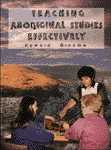
TEACHING
AND LEARNING![]()
start
points
l sensitive
issues
l Dreaming
l background
l resources

Background

In this section
In this part of the site you will find:
- some key ideas
- an outline of essential learnings, with notes for Australian teachers
- a brief introduction to Aboriginal history
- a detailed timeline of one group - the Adnymathanha people
- information about reconciliation
Take the links to the appropriate section Some key ideas
Key ideas
This section explores four key ideas relevant for those planning to teach about Aboriginal people and their cultures.
- beware of stereotyping
- cultural diversity
- involve Aboriginal people
- focus on one group
- sensitive issues
Beware of stereotyping
An excellent background to the teaching of Aboriginal Studies can be found in Teaching Aboriginal Studies Effectively, by Howard Groome, available in our shop.
 |
It covers the background to the development of Aboriginal studies, and a range of teaching strategies. In the past, the Aboriginal people taught about in schools 'were fabrications in the minds of educators'. As this book asserts, the people who were studied were 'caricatures', and bore only minimal resemblance to any pre-invasion Aboriginal people, and none at all to contemporary ones. This book aims to help you correct that situation |
Cultural diversity
Another major pitfall is to assume that all Aboriginal people, and their cultures, are the same.A constant theme of this website is that it is difficult to generalise about Aboriginal people, their cultures and their various histories. (For more information, go to history.)
In teaching and learning about Aboriginal people, a core concept is that there are many, many different Aboriginal cultural groups.
These, and other essential learning, are outlined in the excellent 'Teaching Aboriginal Studies R-12 Guidelines', available from our site. Search for it by title, and it is also available as part of the 'teaching and learning packs'. See our 'packs' section for more details.
Involve Aboriginal people
While many aspects of Aboriginal experience are common, each group has its own land, its own stories, its own history.
How do you incorporate this into your teaching (and learning)?
First and foremost, if at all possible, try and involve Aboriginal people in the planning of what you want to do. In Australia, we have a limited list of Aboriginal people who do this kind of work. Alternatively, contact local Aboriginal education groups, or Aboriginal cultural centres.
Outside of Australia, look for resources which have an Aboriginal voice. All the material on this site meets that requirement.
If you are planning for next year, tell us where you are and we may be able to provide an Aboriginal person to come to your school / college / university to work with your students.
Focus on one group
Keep it simple. Find one group for which you have a range of resources - ideally some information about...- the name of the people
- the land (basic geography) of where they come from
- at least one Dreaming story from that group
- an outline history of what has happened to those people since invasion
With this basic information, you and your students can begin to explore the relationship between those people and that place, and you can begin to see how access to land is so critical. From there, you will be able to explore notions of culture, how culture is sustained, and the role of the Dreaming in all of this. (See our section on the Dreaming for more information).
You will be learning to understand a particular group of people, seeing where they live and how they live in the past and the present. Within that contest, as you begin to understand the relationship between one group and their land, you will be able to extend that understanding to other groups.
Sensitive issues
Before you start, check there aren't some other issues you haven't thought of in the sensitive issues section.
Where to from here?
Back to the start? To issues for Australian teachers? To resources? Back to the main site? Send us a question? Email for our newsletter?
Email us at news@aboriginalaustralia.com.au and put subscribe newsletter in the subject line. Easy.
Start points l sensitive issues l Dreaming l background l resources
![]()